- Defining an Amphibious Aircraft
- The function of the CL-215
- Changes made in the newer models of the aircraft

The Canadair CL-215 is the first model of a “flying boat” or amphibious aircraft designed by Canadian aircraft manufacturer Canadair. This CL-215 is a twin engine, high winged aircraft from the 1960s. The CL-215 was originally used for aerial firefighting as a water bomber because it flies at a low speed and in high wind environments. Even though the main purpose of this aircraft is to put out forest fires, it also functions to transport freight, transport passengers, and air-sea search and rescue operations. Since production of this aircraft was halted in 1990, upgrades were made to the existing aircrafts such as a turbine-powered model of the aircraft that uses Pratt & Whitney Canada PW123AF engines, as well as upgrades to instruments and avionics
Before the first CL-215 was delivered, multiple models of the aircraft had been already in talks of being produced. The CL215A would serve as the standard water bomber configuration, and the CL-215C would serve as the aircraft for bigger fires because of the larger doors on the side and remade underfloor hull structures. This twin engine, high wing amphibious aircraft features a spacious fuselage used to accommodate for the various roles this aircraft may need to perform. This aircraft is known to handle both sky and water very well because the aircraft was remarkable maneuverability even at low speeds. Over the 60 years that this aircraft has been in service, it has been involved in 30 accidents, of which 19 were fatal.


